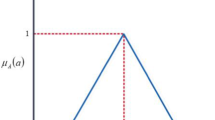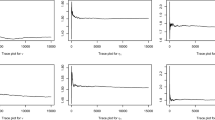Abstract
Understanding the stochastic properties of variability in fatigue crack growth is important to maintaining the reliability and safety of structures. In this study, a stochastic model is proposed to describe crack growth behavior considering the variability of fatigue crack growth rates due to the heterogeneity of material. Fatigue life distribution is then predicted based on this model To construct this model, fatigue tests are conducted on a high strength aluminum alloy 7075 T6 under constant stress intensity factor range control. The variability of fatigue crack growth rates is expressed by random variablesZ and Γ based on the variability of material constantsC andm of the Paris-Erdogan equation. The distribution of fatigue life under constant stress intensity factor ranges is evaluated by the stochastic Markov chain model based on the Paris-Erdogan equation. The merit of the proposed model is that only a small number of tests are required to determine this function, and fatigue life required to reach certain crack length at a given stress intensity factor range can be easily predicted.
Similar content being viewed by others
Abbreviations
- a :
-
Crack length
- a o :
-
Initial crack length
- a r :
-
Final crack length
- b :
-
State number
- B :
-
Thickness
- C, m :
-
Material constants in Paris Erdogan equation
- C o ,m o :
-
Expected values ofC andm
- ΔK :
-
Stress intensity factor range
- N :
-
Number of cycles
- P :
-
Transition matrix
- p :
-
Transition probability
- P o :
-
Initial probability vector
- P x :
-
Probability vector
- s :
-
Number of specimen
- U :
-
Random number
- Z, Γ:
-
Random variables according to material constantsC andm
- α, β:
-
Parameters of the 2 parameter Weibull distribution
References
ASTM E647-93, 1993, “Standard Test Method for Measurement of Fatigue Crack Growth Rates,”
Bogdanoff J. L., 1978, “A New Cumulative Damage Model-Part 1,”Journal of Applied Mechanics, Trans. of the ASME, Vol. 45 pp. 246–250
Bogdanoff J. L., 1978, “A New Cumulative Damage Model-Part 2,”Journal of Applied Mechanics, Trans. of the ASME, Vol. 45 pp. 251–257
Bogdanoff J. L. and Kozin F., 1980, “A New Cumulative Damage Model-Part 4,”Journal of Applied Mechanics, Trans. of the ASME, Vol. 47, pp. 40–44.
Ishikawa H. and Tsurui A., 1987, “Stochastic Fatigue Crack Growth Model and Its Wide Applicability in Reliability-Based Design,”Current Japanese Material Research, Vol. 2, Elsevier, pp. 45–58.
Kim, J. K. and Kim, D. S., 1995, “A Probabilistic Analysis for Fatigue Cumulative Damage and Fatigue Life in CFRP Composites Containing a Circular Hole,”Trans. KSME, Vol. 19, No. 8, pp. 1915–1926
Kim, S. J., Oh, S. G. and Itagaki, H., 1993 “A Study on Effect of Spatial Distribution of Material Properties on its Statistical Characteristics,”Annual of meetings, KSME, pp. 439–442.
Kozin F. and Bogdanoff J. L., 1983, “On the Probabilistic Modeling of Fatigue Crack Growth,”Engineering Fracture Mechanics, Vol. 18, pp. 623–632
Lin Y. K. and Yang J. N., 1985, “A Stochastic Theory of Fatigue Crack Growth,”AIAA Vol. 23 No. 1, pp. 117–124
Lise G., Rune B. and Lars P. H., 1991, “Fracture Mechanical Markov Chain Crack Growth Model,”Engineering Fracture Mechanics, Vol. 38, No. 6, pp. 475–489
Paris, P. and Erdogan, F., 1963, “A Critical Analysis of Crack Growth Laws,”J. Basic Eng., Trans. of the ASME, pp. 528–534.
Sasaki, T., Sakai, S. and Okamura, H., 1992, “Thickness Effect on the Statistical Properties of Random Fatigue Crack Growth Resistance,”Trans. JSME, Vol. 56, No. 548, pp. 509–514
Yoon, H. Y., Yang, Y. S., Yoon, J. H., 1992, “A Stochastic Analysis of Crack Growth Life under Constant Amplitude Loading,”Trans. KSME, Vol 16, No. 9, pp. 1691–1699
Yoshio S., Takao N. and Hisanobu T., 1983, “Reliability Analysis of Fatigue Crack Growth Life by Markov Chain,”Journal of SME, Vol. 33, No. 367, pp. 105–111
Author information
Authors and Affiliations
Additional information
Department of Mechanical Design and Production Eng.
Rights and permissions
About this article
Cite this article
Kim, JK., Shim, DS. A probabilistic analysis on variability of fatigue crack growth using the markov chain. KSME International Journal 12, 1135–1142 (1998). https://doi.org/10.1007/BF02942587
Received:
Issue Date:
DOI: https://doi.org/10.1007/BF02942587




